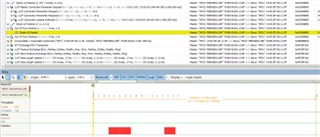Tool/software:
Hi,
1. Through a 1s period software timer, different broadcast data is reloaded once a second, and the connection parameters of an established connection (as the host) are updated to: Interval-1s, Timeout-8s, Latency-0. Through simulation, it is known that GAP_LINK_PARAM_UPDATE_EVENT has been received, but no data packets are sent out in the subsequent connection events as the host, resulting in a connection timeout disconnection.
2. On the basis of 1, the timer period for reloading broadcast data is set to 2s, or the connection interval is updated to 625ms, so that after the connection parameters are updated, data packets are sent out and the connection can be maintained. However, data packets cannot be sent out for each connection event. Generally, it takes 2 to 3 connection intervals to send a data packet.
3. When broadcasting is enabled only at the beginning without reloading broadcast data, the connection can be maintained after the above connection parameters are updated, and the packet sending of the connection event is relatively complete.
Could you please help analyze the reasons for the impact of the above-mentioned heavy broadcast data on existing connections and provide any suggestions on how to avoid it?





